Abstract
This study is based on data provided by the Eurostat, which places Romania on the last place when it comes to preventive medicine and health education. The morphological indexes of the 18- to 20-year-old individuals reach the values of adults, nonetheless, body mass could display relatively high variance even after this age. Lack of physical activity, inappropriate lifestyle and diet combined with study schedules that entail long hours of static body positions increase the risk of obesity among youth, triggering serious health issues. Throughout this study, bioelectrical impedance was used, which provided us with a feasible and relevant method for evaluating body composition among youth population. Bioelectrical impedance makes a series of global and segmented body evaluations using a flow of electricity that penetrates the tissues. This non-invasive technique does not expose the human body to any radiation and can thus be performed multiple times. The research was conducted between 25.09.2017 and 1.03.2018 in the sports hall of the Bucharest Politehnica University Sports Complex, on a sample of 40 overweight female students, with a programme frequency of 3 times per week. These sessions aimed at analysing three indexes: body weight, body fat and caloric consumption. After the intensive programme followed by this group, positive changes have been recorded when comparing initial and final results. This comprehensive study suggests that a minimum number of 2 hours of physical activity (per week) for non-sports universities should be introduced in order to optimize body composition.
Keywords: Obesityyouth populationbioelectrical impedance
Introduction
Overweight and obesity are chronic diseases that develop from an interconnection of the person’s genotype, the environment conditions, diet and physical activity habits (Kotler, Burastero, Wang, & Pierson, 1996).
This study is based on several statistics made by different international and national organizations, where Romania is placed on the top bottom in terms of education for health. The healthy lifestyle of children and youngsters is an issue addressed by several countries, as proven by the WHO effort to implement strategies and pilot projects aiming to ensure their health and welfare (World Health Organization, 2014). Analysing mainly the overweight and obese people, we find that a higher percentage of the female population is affected by obesity, compared to male population. Lack of information about healthy nutrition and an active lifestyle has a major impact on women, about 8% of them ranging within the overweight people category (Eurostat News Release 172/2011, 24 November 2011).
A specialist study showed that overweight or obese children practiced less movement and spent more time in front of TV sets than normal weight children (Braneț, Pelin, Becea, & Wesselly, 2017). Physical inactivity during the transition from adolescence to adult youngster experiences an increase in Romania, only 5% of the young girls aged 15-24 years practicing regular physical activities (Leonte, 2013). Obesity is physically characterised by the large number excess kilos, having an adverse impact on the psyche, by decreasing self-esteem, growing anxiety, leading to isolation from social groups or other people and negative perceptions. The increase in body mass at an early age triggers cardiovascular diseases, diabetes, orthopaedic limitations and, in extreme situations, premature death (Bota, 2007; Coșoveanu & Bulucea, 2011).
The evaluation of body composition is a primary stage in detecting overweight students. Quality of the lifestyle adopted by the subject reflects in the health condition, with major impacts, as proven by the data obtained following the determination of adipose tissue and active muscle mass percentages (Kushner et al., 1990).
A number of similar studies are conducted using the Tanita software for measured indexes, which can make significant differences on each body segment (Ranasinghe et al., 2013; Pasco et al., 2014). This method is reliable, non-invasive, provides accurate measurements and requires a short time spent by the operator (Tanita, 2018).
This study monitors the importance of physical activity in students’ lives, as established in the curricula and practiced during the physical education class, having a significant role in controlling their overweight and obesity. To that purpose, we want to design and implement motor activity programmes for young female students from technical faculties. Such programmes include information on the understanding of physical activity, the need for optimal body composition and the individual ability to maintain balance between intellectual, motor and affective functions. The nature of the designed programmes had an upward evolution in terms of exercise complexity and dynamics, thus making it possible to document concrete training methods for fighting overweight in young females and find optimal solutions for specific physical training methodology.
Problem Statement
Obesity and overweight are deemed to be the disorder of our century, becoming the most common nutritional disease in the world, very similar to a pandemic. Its occurrence involves several interactions between metabolic, genetic, psychosocial, behavioural and economic factors that lead to changes in energy balance.
Research Questions
Considering the curricula of technical faculties and the specific needs of female students, the physical education staff is preoccupied to deliver physical training programmes drawn up to address specific issues, namely body composition imbalances, which affect, in the long run, not only the physical status, but also the self-image or self-esteem of this group of subjects. We are interested in evaluating certain aspects related to body composition, so that the programmes can be customised for individual needs. The main issue in delivering successful physical education classes is to ensure that the minimum volume of effort is provided, but this is hard to achieve with one lesson per week. Can this positive effect be achieved with more training sessions per week? Gathering relevant data might be a proper way to document the need to introduce more lessons in the academic curricula of the Politehnica University of Bucharest.
Purpose of the Study
The purpose of the study is to test, evaluate and monitor body mass index, adipose tissue and caloric consumption in overweight young female students from the Politehnica University of Bucharest. Consequently, we intend to reveal the effects of a clearly established physical activity training programme, which provides us with actual data on the measured indexes.
Research Methods
Subjects
The investigated sample included 40 female subjects aged 19-25 years, students at the Politehnica University of Bucharest. The participating subjects were informed about the purposes of the study. According to ethical considerations, all subjects gave their formal consent on the processing, review and storage of the test results. No personal identification data were used during the study.
The selection was based on identifying first-year overweight and obese female subjects, relevant for the purpose of this study, from one of the Politehnica faculties. All subjects were clinically healthy.
The study was conducted between 25.09.2017 and 1.03.2018 in the sports hall of the Bucharest Politehnica University Sports Complex. Optimal conditions were ensured for testing and evaluating the group of subjects.
The initial test was carried out from 25 to 29.09.2017, and the final test, on March 1st, 2018.
Research methods and techniques used
The research methods used were: bibliographic study, direct and indirect observation, experimental method, test method and statistical-mathematical method.
In order to evaluate adipose tissue or caloric consumption, we used the Tanita FitScan BC-601 equipment, which proved to be a reliable and accurate method to measure body composition by the safe transmission of electrical signals through the body. The software equipment monitors and evaluates the effectiveness of physical activity programmes, enabling their adjustment and correction. The information on muscle mass or muscle fat, as measured by using the BIA (bioelectrical impedance analysis) technology, based on the transmission of data provided by 8 electrodes, also enables accurate calculation of the caloric consumption that a subject should have, according to each one’s anthropometric variables.
The Tanita FitScan BC-601 equipment is used as follows: the apparatus is started when the subject takes the handle being in the pronation position, and then the subject stands barefoot on the apparatus until her weight is stable. Once the subject’s kilos are measured, the handle can be released, because the analysis of each body segment shall start.
Within the research, subjects are tested twice (initial test and final test). After the completion of body analysis for each subject, all data are promptly stored on a memory card from where they can be easily downloaded to a PC.
Research design
This paper is an empirical ascertaining research including the elements of a pilot project. It uses the Tanita FitScan BC-601 software, pointing out individual characteristics for the determination of body mass index (BMI) in overweight young female students. The study was carried out according to the programmer’s schedule and the subjects’ timeliness. Data taken over from the Tanita scale software were recorded in observation protocols based on which the tables and graphs were statistically and mathematically processed.
The training had a complex content focused on three types of exercises, different as structure, but all aiming at loosing adipose tissue and toning muscle groups. The effort intensity curve varied between 40% (given the level of motor and technical abilities for beginners) and 80% when students began to learn the routines and exercise in a continuous, more dynamic manner (Figure
The training sessions included aerobic gymnastics, Pilates and Fitness classes totalling 43 sessions during 15 weeks. The basic elements in the aerobic classes were endurance and coordination on different musical rhythms. The Pilates classes included exercises for core muscles, followed by stretching exercises for relaxation of the involved body segments, while the Fitness classes included circuit-type work on muscular groups, with different apparatus (weights, steppers, boss).
According to references, adipose tissue reduces when the effort intensity ranges between 65-80% from VO2 max. Given the correlation between VO2 max and maximal heart rate (HRmax), the investigated subjects worked out at levels of intensity which raised their heart rates between 65-80% from their maximal heart rate. Generically, maximal heart rate depends on the chronological age, while caloric consumption during exercise varies according to weight. These two parameters have to be taken into consideration when drawing up the exercise programmes.
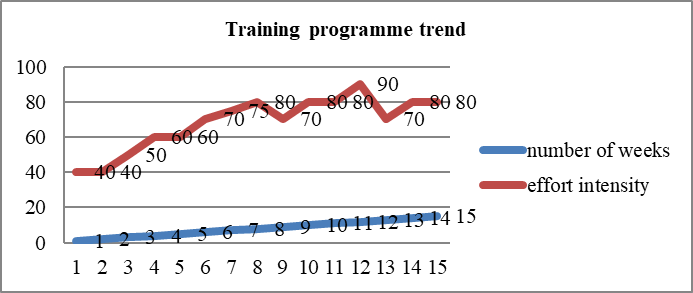
Findings
Table
We found that, when evaluating the weight index, the related arithmetic mean at initial testing (IT) is 71.10 kg, and at final testing (FT), 68.87 kg. The arithmetic mean difference between IT and FT is 2.22 kg (Figure
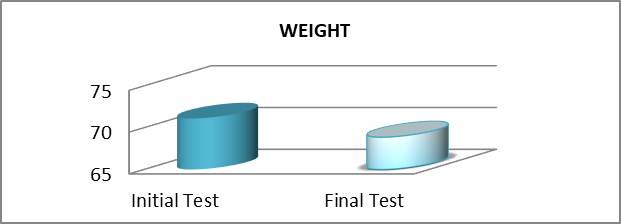
Following the determination of the total adipose tissue of subjects, the arithmetic mean value at initial testing (IT) is 31.93%, and at the final testing (FT), 31.18%. The arithmetic mean difference between IT and FT is 0.75% (Figure
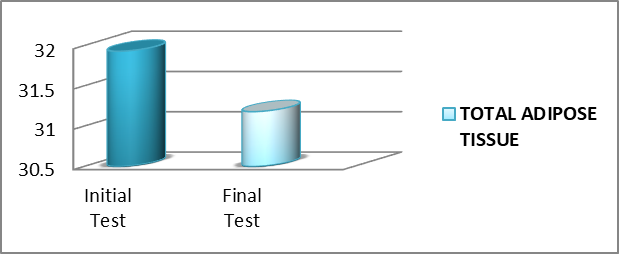
Figure
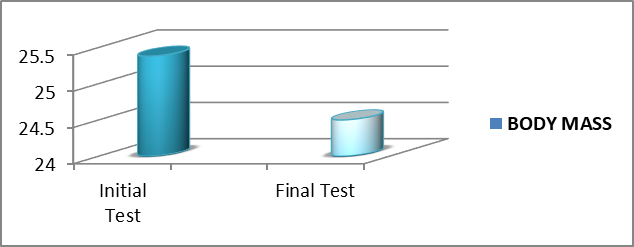
We note that following the determination of caloric consumption, the arithmetic mean value at initial testing (IT) is 2381.46 cal, and at final testing (FT), 2222.86 cal (Figure
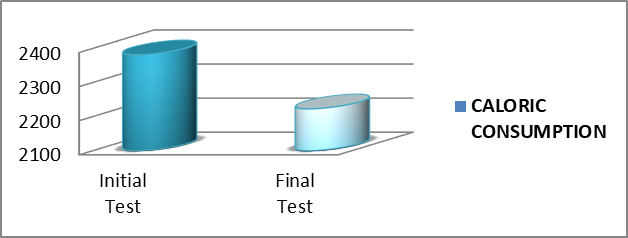
Similar results were emphasised for overweight and obese student population (Popescu, 2015), physical parameters and different dimensions of personality being equally influenced due to physical education lessons.
Our study also matches the view of some authors (Dishman, Heath, & Min Lee, 2013), who state that, for most overweight subjects, the weight loss has to be prudent, namely max 10% of weight over a period of six months. This goal can be attained by a supplementary caloric consumption of 300-500 kcal, which is the equivalent of 1 hour of high-impact aerobics class for an 80-kg female student.
Conclusion
The outcomes obtained following the use of modern technology, such as bioelectrical impedance and appropriate software, clearly and specifically show the importance of aerobic programmes in generating beneficial changes in body composition. Forming motor habits by the systematic and regular practice of physical training programmes led to values as close as possible to normal values, starting from a BMI value that ranged the students within the category of overweight to values typical for normal weight category. The biological potential of an individual begins to diminish if his/her biological structures are not stimulated on a regular basis. Practicing physical activities for health, fitness and emotional balance seems like an ideal way to fight stress and gain abilities to enhance school and professional performance. Physical activities within the academic curricula are clearly connected to losing weight, optimize body composition and caloric consumption. If these results are brought into the everyday lifestyle of students by reinforcing healthy behaviours, long-term outcomes will be achievable.
The data of this study confirm that a well-adjusted physical exercise programme can positively influence physical and functional parameters within a reasonable timeframe if exercise characteristics are customised according to the group requirements.
Acknowledgments
This work was funded by the Politehnica University of Bucharest through the “Excellence Research Grants” Program, UPB-GEX 2017. Identifier: UPB-GEX 2017, No. 98/25.09.2017 (EMTASOI)
All authors contributed equally to this study and should be considered as main authors.
References
- Bota, A. (2007). Nutriție, energie și performanță motrică. București: Printech.
- Braneț, C., Pelin, R., Becea, L., & Wesselly, T. (2017). Study on the relationship between BMI and vertical jump in children aged 8-9 years. The European Proceedings of Social & Behavioural Sciences, 36, 91-100. doi: 10.15405/epsbs.2018.03.12
- Coșoveanu, S., & Bulucea, D. (2011). Assessment of the preschool and school obese and overweight children. Jurnalul Pediatrului, XIV(53-54), 33-36.
- Dishman, R., Heath, G, & Min Lee, I. (2013). Physical activity epidemiology. Human Kinetics.
- Eurostat News Release 172/2011 (24 November 2011). Report – Children’s Health 2013. Retrieved from
- http://epp.eurostat.ec.europa.eu/cache/ITY_PUBLIC/3-24112011-BP/EN/3-24112011-BP-EN.PDF
- Kotler, D. P., Burastero, S., Wang, J., & Pierson, R. N. Jr. (1996). Prediction of body cell mass, fat-free mass and total body water with bioelectrical impedance analysis: Effects of race, sex and disease. The American Journal of Clinical Nutrition, 64(3), 489-497.
- Kushner, R. F., Kunigk, A., Alspaugh, M., Andronis, P. T., Leitch, C. A., & Schoeller, D. A. (1990). Validation of bioelectrical impedance analysis as a measurement of change in body composition in obesity. The American Journal of Clinical Nutrition, 52(2), 219-223.
- Leonte, N. (2013). Model for the pro-movement attitude conceptualization in adolescent girls. Procedia – Social and Behavioral Sciences, 92, 474-479. doi: 10.1016/j.sbspro.2013.08.704
- Pasco, J. A., Holloway, K. L., Dobbins, A. G., Kotowicz, M. A., Williams, L. J., & Brennan, S. L. (2014). Body mass index and measures of body fat for defining obesity and underweight: A cross-sectional population-based study. BMC Obesity, 1: 9. Retrieved from https://dx.doi.org/10.1186%2F2052-9538-1-9
- Popescu, V. (2015). Improving self-image in overweight and obese students through the systematic practice of fitness, Pilates and stretching exercises. Discobolul – Physical Education, Sport and Kinetotherapy Journal, XI, 2(40), 5-9.
- Ranasinghe, C., Gamage, P., Katulanda, P., Andraweera, N., Thilakarathne, S., & Tharanga, P. (2013). Relationship between body mass index (BMI) and body fat percentage estimated by bioelectrical impedance in a group of Sri Lankan adults: A cross sectional study. BMC Public Health, 13, 797-802.
- Tanita, (2018). Why choose Tanita? Retrieved from http://www.tanita.com/en/why-choose-tanita
- World Health Organization. (2014). Investing in children: The European child and adolescent health strategy for 2015-2020. Retrieved from http://www.euro.who.int/__data/assets/pdf_file/0010/253729/64wd12e_InvestCAHstrategy_140440.pdf
Copyright information

This work is licensed under a Creative Commons Attribution-NonCommercial-NoDerivatives 4.0 International License.
About this article
Publication Date
16 February 2019
Article Doi
eBook ISBN
978-1-80296-054-9
Publisher
Future Academy
Volume
55
Print ISBN (optional)
-
Edition Number
1st Edition
Pages
1-752
Subjects
Sports, sport science, physical education
Cite this article as:
Mezei, M., Popescu, O., Pricop, A., & Răchită, I. (2019). Aspects Of Body Composition In Overweight Students Using Bioelectrical Impedance Measurements. In V. Grigore, M. Stănescu, M. Stoicescu, & L. Popescu (Eds.), Education and Sports Science in the 21st Century, vol 55. European Proceedings of Social and Behavioural Sciences (pp. 691-698). Future Academy. https://doi.org/10.15405/epsbs.2019.02.85
